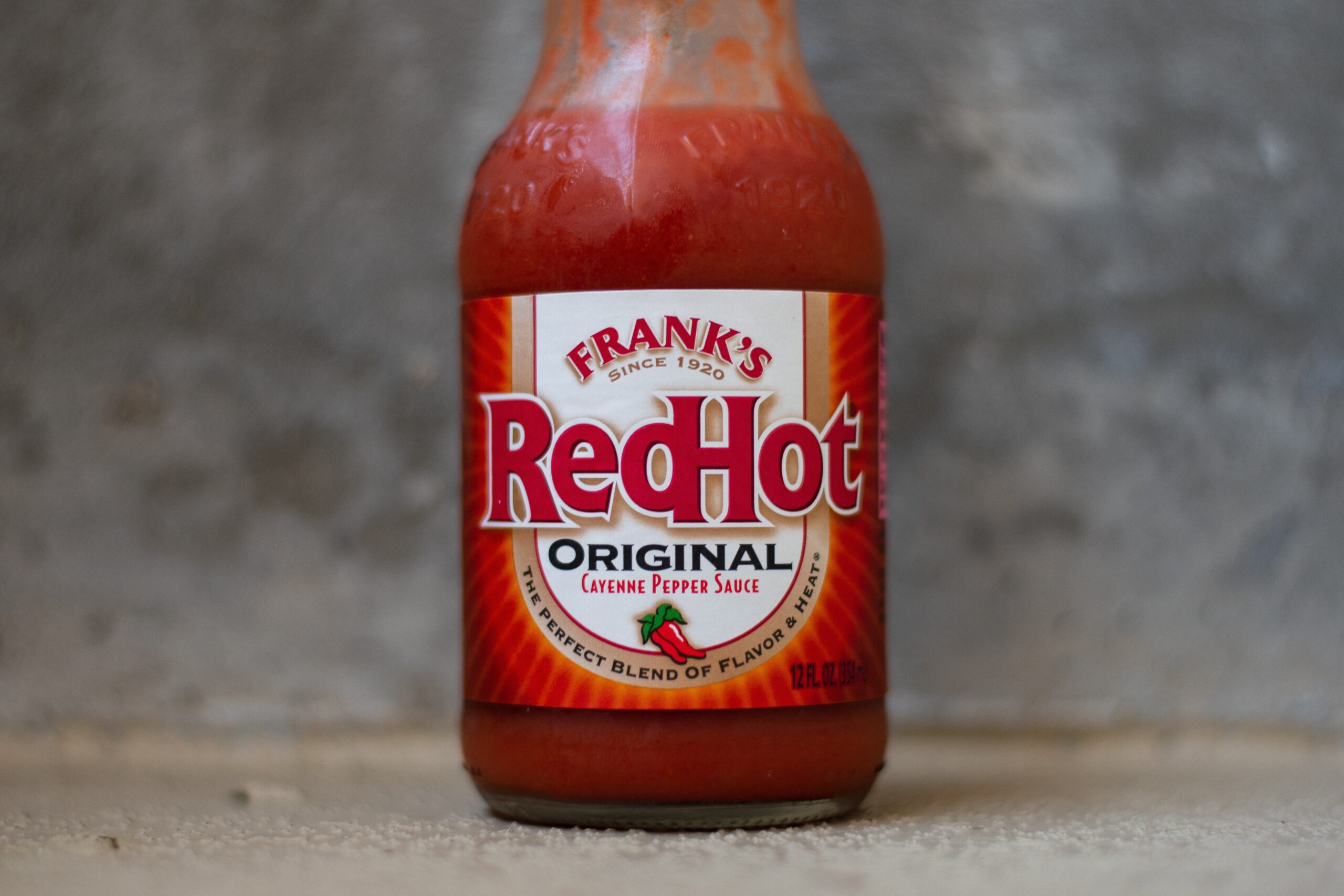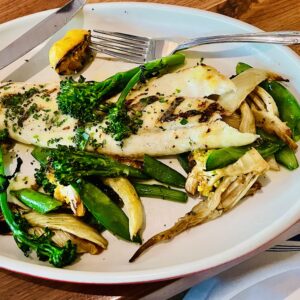Earlier we explored what kinds of foods you can eat a lot of without gaining weight. Now let’s turn to the stuff that makes the food GOOD – the condiments. Sauces, dressings, and syrups can make or break a meal. Especially if the food you are eating is low on fat, oil, or sugar, something extra to enhance the flavor will help you derive better satisfaction and get less hungry later.
As we explored in our condiment calorie bomb article, standard and common sauces and dressings can have a very expensive calorie price tag. A salad dressing that doesn’t even cover half a salad can be twice the calories of the salad itself.
A little bit of sauce here and there may not seem like much, but the cost of not being picky can add up to hundreds of extra calories a day. And you are in luck. I am the QUEEN of picky. The market is saturated with options that give you the taste without the bigger waist. As someone who has spent a significant amount of time in the middle aisles of the grocery store, I can give you a well-informed opinion on what to pick up and what to put down.
The Prego story
As someone in the consulting space, I am fascinated by marketing and how brands went from unknown to successful for decades. As I was doing the research for this article, I came across the famous “Prego story,” which talks about how Prego overtook the market by identifying an overlooked niche in its customers.
Back in the 1980s, Prego did some research on what kind of spaghetti sauce was most favored by an American audience. The research found that over one-third preferred chunky sauce, yet there was NO kind of chunky sauce on the market. After developing their brand of chunky sauce, Prego generated $600 million in 10 years.
Now that we are in 2021, we have countless varieties of almost every kind of condiment. You can get extra chunky, lower sodium, extra creamy, mild, hot, medium, sweet, non-dairy, etc.
How does the Prego story related to this article? The one niche that has generated the most recent explosion in variety is the fitness niche. Manufacturers are well aware that we are willing to pay premium for yummy sauces that don’t have sugar or extra fat, but that we still want the food to be yummy. The key is understanding the broader categories of healthy condiments, which we will now review.
Most calorie-friendly condiments
First, you should have a basic understanding of the general categories of condiments that have fewer calories. That way, you can recognize the products that have better value for calories when you want to select say, a healthier variety of ketchup. After I list the top 10, I will also list some of the high-level categories of condiments that tend to have more sugar and higher calories, then give some of the most prominent brand alternatives.
Number 10: Vinegar
Vinegar is an overlooked condiment because most people assume it has to be combined with oil or something else to infuse salads with taste. Not so. If you combine vinegar with some lemon juice and black pepper, it becomes really tasty. You can also drizzle vinegar over vegetables, in soups, and stews. The key is to know what food goes with what vinegar. If you look at the labels of most low-cal dressings and sauces, some type of vinegar is usually one of the first ingredients.
Best vinegar for salad: Balsamic
Balsamic Vinegar is much more fun than regular vinegar because it has a thickness and more robust taste at 10 calories a tablespoon. You can even use a balsamic glaze to make the taste even more noticeable, which is 30 calories a serving.
Best vinegar for cooking: Rice vinegar
Even if your dress isn’t “Asian” in nature, you can quickly give vegetables that flavor by adding a tablespoon or two of rice vinegar, which only clocks in at 15 calories a tablespoon
Best vinegar for soups and stews: Red wine vinegar
Red wine vinegar also makes a great salad dressing, because of the tart taste. You can easily have a great Greek salad with just red wine vinegar on top. Many greek salads on restaurant menus add olive oil to the dressing, but you don’t need it. There is already enough fat from the cheese and the olives. One of the principles of the thermic effect of food is that food you can chew, which activates your calorie burning abilities, is better than liquid food, which really does not involve that process.
Best all around vinegar: Apple cider
Apple cider vinegar is known for its weight loss benefits, This is one of the vinegars you can drink on its own because of the slightly sweet taste. It also makes a good salad topper and ingredient to sub in for cooking vegetables and/or proteins instead of oil.
If you choose one of the vinegars as a salad dressing, make sure that the salad has some other kind of fat, like olives, avocado, or feta/goat cheese. These are all good options because a little goes a long way in flavor. Just make sure that the portion size of each of these is about a thumbful (you would want to aim for 4-5 olives if that is what you are using. If you are using nuts or seeds, keep it to two tablespoons for the serving. You can buy a good soon measuring device here.
If you aren’t happy with vinegar only salad dressings, I have a post with DIY salad dressing that involve these vinegars with extra ingredients to make your salad creamy, delish and still low calorie.
Number 9: Citrus juice (lemon, lime, pineapple, organge)
At basically zero calories, lemon juice is an excellent addition to water, salads, chicken, seafood, and vegetable dishes. Similarly, fresh orange and pineapple juice can make a great marinade for chicken or salad. What I do for the peeled citrus is take one of those squeezers you can buy from the store and squirt it over whatever I am making. For pineapple, I usually enjoy eating it fresh so I take the juice that it collect at the bottom of the container and I add it in. Note that you will want to use fresh, not canned or juiced fruit, for this purpose. Again, most of the Pale0/Keto/Whole30 friendly sauces have one of these types of juices as an ingredient.
Number 8: Tahini
Tahini is normally associated with Middle Eastern dishes like Falafel, but it has achieved real cross-over. It can be part of a salad dressing ingredient mix, a standalone dip, and a veggie marinade. It goes really well with roasted carrots and cauliflower. You can find some great recipes on this site. The best pre-made tahini I know is the Cava spicy lime tahini, whihc you can obviously get when you go to Cava but also find bottled versions you can buy at Whole Foods.
Number 7: Hummus
Humms also makes an excellent salad topper and veggie dip! You can even mix it with your vinegar orf choice to make a nice dressing. For approximating the 2-tablespoon serving size, think two golf balls. A close cousin of hummus is baba ganoush, which is an eggplant dip that only has 30 calories for 2-3 tablespoons.
Number 6. Salsa
Salsa is a chunky and robust addition to salads, omelets, and makes an excellent raw veggie dip. At your next gathering, load up on the raw veggies and reach fo the salsa that’s next to the chips instead of that white veggie dip that probably is 200 calories for just a small couple of spoons.
Number 5: Guacamole
Normally guacamole gets a bad rep; this may be more true for restaurant served brands that add extra cream but store-bought brands mostly are just mashed avocado with lemon juice, salt and pepper. 2 tablespoons (2 golf balls). Again, this makes a great salad dressing and veggie dip, not to mention a more convenient way to make avocado toast.
Number 4: Mustard
Not only are there endless varieties (German, Dijon, brown, yellow, habanero), but mustard can be mixed with vinegar to make a nice vinaigrette and punch up a salad flavor. It can be a condiment for almost any protein, especially English mustard, which is great with steak, chicken and fish.
Number 3: “Soy sauce” alternatives: Coconut aminos and tamari sauce
I have sung the praises of this soy sauce substitute in my previous posts, and for good reason – it’s an excellent substitute for soy sauce, without the MSG or high level of sodium. It’s about 15 calories a tablespoon. It also makes a good substitute for Hoisin sauce or Teriyaki because of its sweetness (Teriyaki and hoisin sauce are normally very high in sugar and calories).
Tamari is s japanese sauce that is similar to soy sauce, like coconut aminos. I would say this one is a little more “soy-saucey”. It is about the same calories, at 15 calories a tablespoon.
Number 2: Greek Yogurt
Greek yogurt is a great alternative to sour cream for Mexican type of dishes, and also makes a gorgeous veggie dip. I have a whipped feta recipe in my updated recipe post for you to try. Cottage cheese is also another salad topper option if you like the texture. Both deliver a hefty dose of protein, making them standalone sufficient sources when you are having your salad.
Number 1: Hot sauce
This is the winning condiment for me. It makes everything from eggs to broccoli more tasty. Also, hot sauce has a thermic effect that accelerates metabolism. The hot sauce made with chili peppers, in particular, suppresses appetite because of its capsaicin, Some of my favorite brands include Cholula, Crystal, and Melinda’s. Texas Pete and Tabasco served at most restaurants are also good choices.
Chili sauces – this includes subtypes like Piquante and Sriracha, which use chili peppers. You have to be a bit careful with Sriracha, and I explain that below.
Habanero sauce – Habanero is a subtype of chili pepper sauce, but it is the HOTTEST pepper and only should be used sparingly.
Jalapeno sauce – this is often referred to in restaurants as the “green hot sauce,” using jalapeno peppers as the spice. It tends to be a bit milder, because most of the brands don’t grind in the seeds
Harissa sauce – This is a Moroccan red pepper sauce, that can be spice or mild. The most prominent brand is Mina Harissa, and it is only 10 calories per tablespoon. Good on steak, chicken, or even as a pasta sauce.
Indian Hot lime relish – Having an Indian husband and Indian in-laws I have to cover this If you have never had hot lijme relish, you have not lived. Just a little mixed with veggies like cauliflowr, okra, or proteins like chicken or fish makes it out of this world sour and hot. Definitely read labels before you buy, because most of the brands add a little bit of oil. The one that I found that is calorie-friendly and that you can order on Amazon is Patak’s, which is also sold at main chain grocey stores like Kroger
Persian toorshi – by now you may have figured out I am Persian. Our dishes are not typically so spicy but we do add Toorshi, which is a home made pickled sauce usually having carrots, celery, eggplant herbs and vinegar. The juices all flow together and it is slightly spicy. It basically goes with every kind of meat and cooked vegetables. I am fortunate to get this homemade (every self respecting Persian has a jar of Toorshi in the fridge!) but you can also buy it online here. and if you are curious enough, get the recipe here.
Bottled condiments and substitutes you can make
Ketchup – Ketchup is actually not too high in calories, at 20 calories per tablespoon, but many of us rarely eat a tablespoon at a time. Also, ketchup has a high amount of sugar, usually in the form of high fructose corn syrup which is one of the worst kinds. A good alternative to regular ketchup is a low or no sugar variety like this one from Primal Kitchen, which is Keto and Whole30-friendly. .
Regular sriracha – Although hot sauces are good for the metabolism, the traditional Sriracha with the green top has 5 calories of mostly sugar per TABLESPOON. A tablespoon is about the tip of your index finger. Again, rarely does anyone eat this little. Luckily many brands, like Paleochef, have made no-sugar Sriracha varieties.
Regular Mayo – If you are making chicken or tuna salad and still want that creaminess, you don’t have to pay dearly with 100 calories a tablespoon for normal mayo. You can use light mayo for only about 35-40 calories. It can also be combined with vinegar to make a light salad dressing. Just mix the vinegar, mayo, and salt and pepper and you have a creamy salad dressing for under 40 calories. You can also get vegan mayo options., like from Primal Kitchen or Avonaise. Since these are made with Avocado oil, they have more calories, so make sure to use a 1/2 tablespoon instead of a full tablespoon.
Ranch- Ranch is not one of those “take it or leave it” condiments. Everyone I know either hates ranch or loves it so much that they would have it in an IV drip if they could. So it doesn’t seem fair to say Ranch is bad, don’t eat it. The normal Hidden Valley ranch dressing is 140 calories and 14 grams of fat per 2 tablespoons. Even though the light version is half the calories, it still has 7 grams of fat AND added sugar to make up for the lack of fat.
A good alternative to ranch dressing is to buy the dry ranch flavoring and mix it with Greek Yogurt. Hidden Valley also makes dry ranch dressing packets. And, you can even buy an organic, non-GMO version. Once you get a hold of these just whip it up with some greek yogurt and you have a great dip. If you want to make it more like a salad dressing, blend it and add some water.
French dip – Instead of regular French dip which can have 100 calories per serving, try Kite Hill’s Almond Milk version for only 30 calories. This brand also makes some great plant based dips.
BBQ sauce – Pulled chicken, pulled pork, even beans and some salads (think cobb and buffalo chicken) call for barbeque sauce. Or maybe you are having a healthier version of a chicken sausage and vegan burger cook-out. Noblemade makes some tasty barbeque sauces that are both Keto and Whole 30 friendly. My favorite is the Mustard BBQ flavor, which also has turmeric (a great anti-inflammatory) and makes a great salad dressing.
Spaghetti sauce – since I told the Prego story I should recommend some sauces you can substitute. Most sauces clock in at 90 calories for a measly half a cup and although low in fat, have a lot of added sugar for taste. Marinara sauce is a great topping for zoodles and cauliflower rice risotto, so you definitely don’t want to miss out on flavor. One substitution you can make is to buy the canned fire roasted tomatoes, which taste just about the same with a little bit of salt, pepper and basil. If you want spaghetti sauce straight from the bottle, you can try Primal Kitchen spaghetti sauce, which also comes in arrabiata, vodka, and tomato basil flavor. For low-carb spaghetti options, try spaghetti squash or shirataki noodles.
I told you, there is no niche left unturned! The world is your sauce oyster.
Key takeaway
Condiments do not have to be calorically costly. You can still enjoy your healthy food and not have to eat a bland diet. Make sure you read the labels and watch measurements, and you will be a condiment connoisseur in no time!






